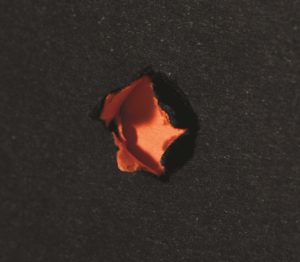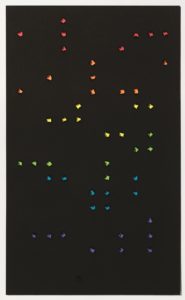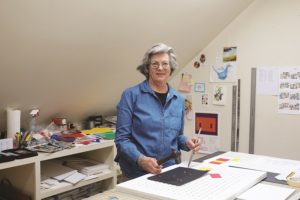“Enough is enough, and it’s time for us to take action,” said U.S. Rep. Joe Neguse after the March 22 shooting at the King Soopers grocery in Boulder, Colo.
At the time, Jane Lincoln was preparing for her show, “Enough,” at the Cape Cod Museum of Art. Hearing Neguse’s words was eerie, she says — almost like déjà vu. The yearning for action was why she embarked on the project in the first place.

“Enough,” with 43 mixed media works, is on view from Thursday, April 8 through May 30. Originally, it included 41 pieces. But after the March shootings in Atlanta and Boulder, Lincoln had to make two more.
Lincoln grew up in New Hampshire. Her father was a nuclear physicist with NASA, and her mother was a librarian. In the ’80s, she studied color theory with Henry Hensche in Provincetown. From 2009 to 2011, she got a master’s degree through a combined MassArt/Fine Arts Work Center program (that has since been discontinued), studying with Jim Peters in Provincetown. Her thesis was about the grid.
“Grids were the first totally abstract art. They’re everywhere,” Lincoln says. Their structure fascinates her.
Lincoln was originally a representational painter. “Early on, I was tagged as the ‘cranberry queen,’ ” she says, because her favorite subjects were cranberry bogs. But a series of “personal puzzles” she created — based on Sudoku grids — drew her into the abstract. Another series, called “color zones,” is made of painted paper on archival boards with fluorescent paper on the back, creating a sort of halo effect. She also makes abstract white line wood block prints that evoke Provincetown for her — a place she loves.
In her East Falmouth studio, Lincoln explains the creative process for “Enough.” She started making the pieces in January 2019. She’d been working with punctured paper for the show “Pushing Forward,” at the Kingston Gallery in Boston. Then, the SunTrust Bank shooting in Sebring, Fla. happened. She realized she was making what looked like bullet holes.

She made SunTrust Bank first — it’s 8 by 12 inches, with five angry orange holes. Since then, she has made Sandy Hook, Pulse Nightclub, Virginia Tech, and others.
For the background, she uses black pastel paper, which is thin enough to puncture, but thick enough to hold up. On two sheets of this, she glues smaller pieces of colored paper in mirror images of one another. Then, using a hammer and large nail, she pokes holes in one of the sheets. It’s done on a grid. “As you can see, I like grids,” she says.
The black paper rips and frays to reveal the color underneath in a way that’s visceral. Indeed, there is something almost violent about Lincoln’s artistic process. It’s a real contrast to her sweet, friendly demeanor. When being photographed for this article, she insists on not smiling too much, reflecting the seriousness of the subject.
Making the pieces requires obsessive information gathering, she says. All of them are 12 inches wide, because “they should all have the same attention,” she says. The height depends on the number of victims. On the labels, in addition to the name of the shooting, the place, and the victims, she includes the day of the week. That detail is important to her.
King Soopers, for example, consists of 10 holes in a black background. The holes are red, yellow, and white — the colors of the King Soopers logo. “The composition goes with the sequence of events,” she says. Two men were killed outside, represented by two yellow holes. Then a police officer was killed, represented by a white hole. Inside, seven people were killed, represented by red holes for women, yellow holes for men.
Massage Parlors consists of eight holes, seven that are hot pink to represent the women who were killed in Atlanta, and one that’s lilac to represent the man who was shot dead with them.
One could argue that there is something dehumanizing about representing human lives lost by holes in paper. But maybe that’s the point. The total number of victims defies empathetic comprehension. The smallness of the works — something that doesn’t come across in photographs — evokes the fragility of human life.
As an exhibit, “Enough” is indeed powerful, but its strength is in its implied limitations: the numbers must stop growing.
Bullet Points

The event: “Enough,” an exhibit of artwork by Jane Lincoln
The time: April 8 through May 30; reception Thursday, April 15, 4 to 7 p.m.; hours, Thursday through Saturday, 10 a.m. to 4 p.m.; Sunday, noon to 4 p.m.
The place: Cape Cod Museum of Art, 60 Hope Lane, Dennis
The cost: Reception, free; regular hours, $10; seniors 62+, $8; teens and students 19+, $7; members and children 12 or under, free



